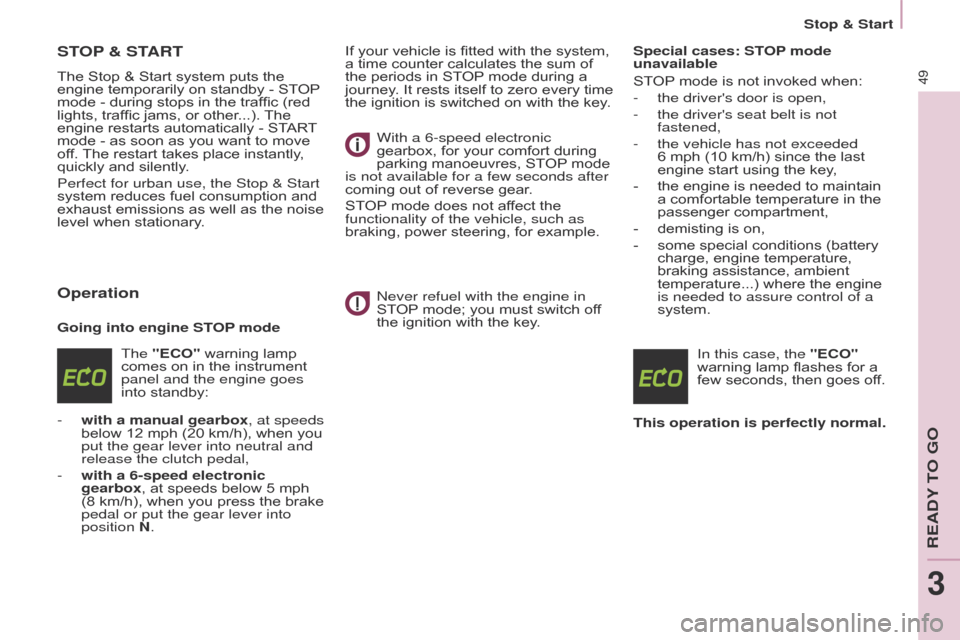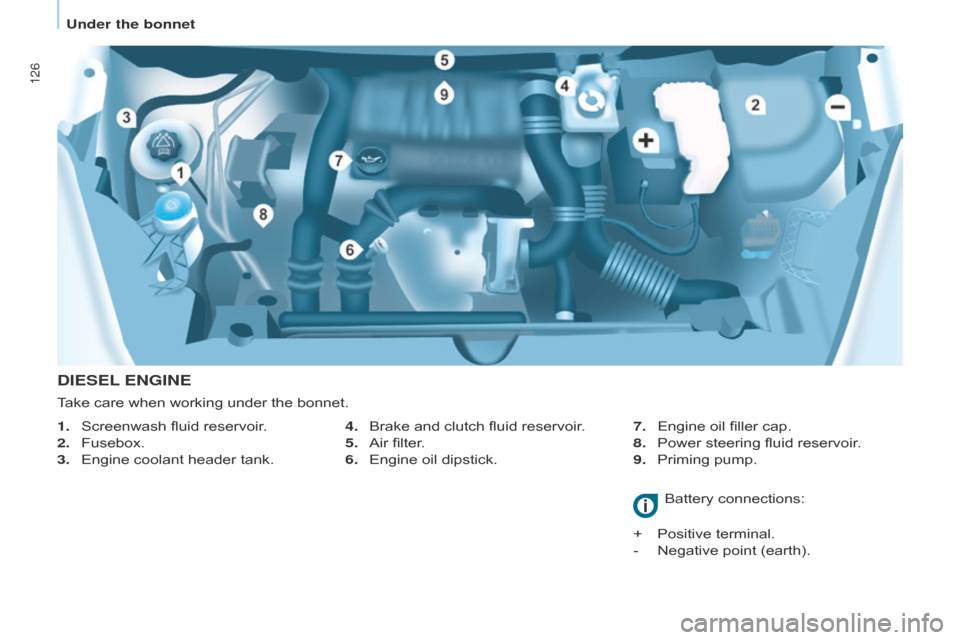2016 Citroen BERLINGO RHD clutch
[x] Cancel search: clutchPage 47 of 260

45
Berlingo-2-VU_en_Chap03_Pret-a-partir_ed02-2015Berlingo-2-VU_en_Chap03_Pret-a-partir_ed02-2015
MANUAL GEARBO x
5-speed
6-speed
To change gear easily, always depress
the clutch pedal fully.
To prevent the mat from becoming
caught under the pedal:
-
ensure that the mat is positioned
and secured correctly on the floor
,
-
never fit one mat on top of another
.
When driving, avoid leaving your hand
on the gear knob as the force exerted,
even if slight, may wear the internal
components of the gearbox over time.
Changing into 5th or 6th gear
To engage the gear correctly, move the
gear lever fully to the right. In the 6-speed configuration, raise the
collar below the gear knob.
Engaging reverse gear
S
TEERING
WHEEL
ADJUSTMENT
When the vehicle is stationary,
release the steering wheel adjustment
mechanism by pulling the lever.
Adjust the steering wheel for height
and reach, then lock the mechanism by
pushing the lever fully forward. The lever should be moved slowly
to reduce noise.
To engage reverse gear, wait until the
vehicle has come to a complete stop.
REadY To Go
3
Gearbox and steering wheel
Page 51 of 260

49
Berlingo-2-VU_en_Chap03_Pret-a-partir_ed02-2015Berlingo-2-VU_en_Chap03_Pret-a-partir_ed02-2015
STOP & START
The Stop & Start system puts the
engine temporarily on standby - ST OP
mode - during stops in the traffic (red
lights, traffic jams, or other...). The
engine restarts automatically - START
mode - as soon as you want to move
off. The restart takes place instantly,
quickly and silently.
Perfect for urban use, the Stop & Start
system reduces fuel consumption and
exhaust emissions as well as the noise
level when stationary.
Operation
Going into engine STOP mode
The "ECO" warning lamp
comes on in the instrument
panel and the engine goes
into standby:
-
with a manual gearbox
, at speeds
below 12 mph (20 km/h), when you
put the gear lever into neutral and
release the clutch pedal,
-
with
a 6-speed electronic
gearbox, at speeds below 5 mph
(8 km/h), when you press the brake
pedal or put the gear lever into
position N. If your vehicle is fitted with the system,
a time counter calculates the sum of
the periods in STOP mode during a
journey. It rests itself to zero every time
the ignition is switched on with the key.
With a 6-speed electronic
gearbox, for your comfort during
parking manoeuvres, STOP mode
is not available for a few seconds after
coming out of reverse gear.
STOP mode does not affect the
functionality of the vehicle, such as
braking, power steering, for example.
n
ever refuel with the engine in
STOP mode; you must switch off
the ignition with the key. Special cases: STOP mode
unavailable
STOP mode is not invoked when:
-
the driver's door is open,
-
the driver's seat belt is not
fastened,
-
the vehicle has not exceeded
6 mph (10 km/h) since the last
engine start using the key,
-
the engine is needed to maintain
a comfortable temperature in the
passenger compartment,
-
demisting is on,
-
some special conditions (battery
charge, engine temperature,
braking assistance, ambient
temperature...) where the engine
is needed to assure control of a
system.
In this case, the
"ECO"
warning lamp flashes for a
few seconds, then goes off.
This operation is perfectly normal.
READY TO GO
3
Stop & Start
Page 52 of 260

50
Berlingo-2-VU_en_Chap03_Pret-a-partir_ed02-2015Berlingo-2-VU_en_Chap03_Pret-a-partir_ed02-2015
Going into engine START modeThe "ECO" warning lamp
goes off and the engine starts:
-
with a manual gearbox
, when you
fully depress the clutch pedal,
-
with
a 6-speed electronic
gearbox:
●
gear lever in position
A or M,
when you release the brake
pedal,
●
or gear lever in position
N and
the brake pedal released, when
you move the gear lever to
position A or M,
●
or when you engage reverse
gear
.
With a manual gearbox in STOP
mode, if a gear is engaged without
fully depressing the clutch pedal, a
warning lamp comes on or a message
is displayed asking you to depress the
clutch pedal to restart the engine. Special cases: START invoked
automatically
For your safety and comfort, START is
invoked automatically when:
-
you open the driver's door
,
-
you unfasten the driver's seat belt,
-
the speed of the vehicle exceeds
15 mph (25 km/h) with a manual
gearbox or 7 mph (1
1 km/h) with
the 6-speed electronic gearbox
system,
-
some special conditions (battery
charge, engine temperature,
braking assistance, ambient
temperature...) where the engine
is needed to assure control of a
system.In this case the
"ECO"
warning lamp flashes for few
seconds, then goes off.
This operation is perfectly normal.Deactivation
At any time, press the "ECO
OFF" switch to deactivate the
system.
This is confirmed by the switch warning
lamp coming on accompanied by a
message in the screen.
If the system has been deactivated
in STOP mode, the engine restarts
immediately.
Stop & Start
Page 55 of 260

53
Berlingo-2-VU_en_Chap03_Pret-a-partir_ed02-2015
Starting and switching off
Berlingo-2-VU_en_Chap03_Pret-a-partir_ed02-2015
HILL START ASSIST
Operation
With the brake pedal and clutch pedal
pressed, from the time you release
the brake pedal, without using the
parking brake, you have approximately
2
seconds to move off before the
vehicle starts to roll back.
During the moving off phase, the
function is deactivated automatically,
gradually releasing the braking
pressure. During this phase, the
characteristic noise of mechanical
release of the brakes may be heard,
indicating the imminent movement of
the vehicle.
Operating fault
Hill start assist is deactivated in the
following situations:
-
when the clutch pedal is released,
-
when the parking brake is applied,
-
when the engine is switched of
f,
-
when the engine stalls. If a malfunction of the system
occurs, this warning lamp
comes on accompanied
by an audible signal and
confirmed by a message in
the screen. Have the system checked
by a CITROËN dealer or a qualified
workshop.
This system (also called HHC - Hill
Holder Control), linked to the dynamic
stability control system, makes hill
starts easier and is activated in the
following conditions:
-
the vehicle must be stationary
,
engine running, foot on the brake,
-
the gradient of the road must be
steeper than 5%,
-
uphill, the gearbox must be in
neutral or in a gear other than
reverse,
-
downhill, reverse gear must be
engaged.
The Hill Start
Assist system is a driving
aid. It is not an automatic vehicle
parking function or an automatic
parking brake.
READY TO GO
3
Page 64 of 260

62
Berlingo-2-VU_en_Chap04_Ergonomie_ed02-2015
Selecting the functionFirst activation /
Programming a
speed Temporarily exceeding the
speed setting
Deactivation (off)
- Press this button or
the brake or clutch
pedal.
Reactivation
- Reach the chosen speed by
pressing the accelerator .
-
Press the
SET - or SET + button.
This programmes/activates the speed
setting and the vehicle will maintain
this speed. -
Place the switch in the
CRUISE
position. The cruise control is
selected but is not yet active and
no speed has been programmed.
It is possible to accelerate and drive
momentarily at a speed greater than
the programmed speed setting. The
value programmed flashes.
When the accelerator pedal is
released, the vehicle will return to the
programmed speed. -
Following deactivation of the cruise
control, press this button.
Y
our vehicle will return to the last
programmed speed.
Alternatively, you can repeat the "first
activation" procedure.
Steering mounted controls
Page 101 of 260

99
Driving safely
Berlingo-2-VU_en_Chap05_Securite_ed02-2015
Operation
When your vehicle is too close to or
approaches the vehicle ahead too
quickly the system automatically
applies the brakes to avoid a collision.
You are then alerted by the display of a
message.
The brake lamps on your vehicle come
on to warn other road users.
The collision can be avoided
automatically if the difference in speed
between your vehicle and the vehicle
ahead does not exceed 9 mph
(15 km/h).
Above this threshold, the system will
do what is possible to avoid or reduce
the accident by lowering the speed of
impact.
The automatic braking may bring
the vehicle to a complete stop if the
situation requires it.
In this case, the vehicle is held
stationary temporarily (for about
1.5 seconds) to allow the driver to take
back control by pressing the brake
pedal.The triggering of the system may
cause the engine to stall, unless
the driver depresses the clutch
pedal quickly enough during
automatic braking.
During automatic braking, the
driver can always obtain a higher
rate of deceleration than that
controlled by the system, by pressing
firmly on the brake pedal.
After an impact, the system is
automatically put out of service: it
no longer operates.
You must go to a CITROËN dealer or a
qualified workshop to have the system
made operational again.
Operating limits
The system only detects vehicles that
are stationary or moving in the same
direction as your vehicle.
It does not detect small vehicles
(bicycles, motorcycles),
pedestrians or animals, nor
non-reflective stationary objects.
The system is not triggered or is
interrupted if the driver:
-
accelerates strongly
-
or turns the steering wheel
suddenly (avoiding manoeuvre). In difficult weather conditions (very
heavy rain, snow
, fog, hail...),
braking distances increase, which
can reduce the ability of the system to
avoid a collision.
The driver must therefore remain
particularly vigilant.
Never leave accumulations of
snow or any object projecting
above the bonnet or in front of
the roof: this might fall into the field of
vision of the sensor and generate a
detection.
SAFETY
5
Page 127 of 260

125
Berlingo-2-VU_en_Chap07_Verification_ed02-2015Berlingo-2-VU_en_Chap07_Verification_ed02-2015
PETROL ENGINE
1. Screenwash fluid reservoir .
2.
Fusebox.
3.
Engine coolant header tank. Battery connections:
+
Positive terminal.
-
Negative point (earth).
T
ake care when working under the bonnet.
4. Brake and clutch fluid reservoir .
5.
Air filter
.
6.
Engine oil dipstick.7.
Engine oil filler cap.
8.
Power steering fluid reservoir
.
CHECkS
7
Under the bonnet
Page 128 of 260

126
Berlingo-2-VU_en_Chap07_Verification_ed02-2015Berlingo-2-VU_en_Chap07_Verification_ed02-2015
DIESEL ENGINE
4. Brake and clutch fluid reservoir .
5.
Air filter
.
6.
Engine oil dipstick. 7.
Engine oil filler cap.
8.
Power steering fluid reservoir
.
9.
Priming pump.
1.
Screenwash fluid reservoir
.
2.
Fusebox.
3.
Engine coolant header tank.
Battery connections:
+
Positive terminal.
-
Negative point (earth).
T
ake care when working under the bonnet.
Under the bonnet